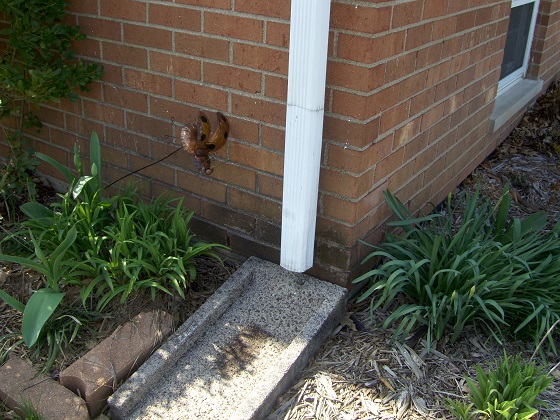Downspout Drain Lines

Drain tiles can stop soil erosion under downspouts. PHOTO CREDIT: Roger Henthorn
DEAR TIM: I purchased some splash blocks to set on the ground immediately below my down spouts. My wife thinks they are useless. I feel that they help divert water away from my foundation and water her gardens at the same time. She thinks that the roof water and my basement sump pump water should be piped away from the house. What do you think? T. E.
DEAR T. E.: Well (no pun intended)... I think I have to side with your wife on this one. The splash blocks are not entirely useless, however. They can effectively control erosion of the soil. The blocks can absorb some of the energy of the moving water before it hits the soil.
Rainwater that drains onto soil near your home is generally not a problem if you have sandy or very well drained soil. However, a large portion of the USA does not have well drained soil. Many of us (including myself) live in regions that have clay rich soils. Clay soils don't always drain that well. Basements and crawlspaces can become indoor swimming pools in periods of heavy rainfall or sustained wet spells.
Many people do not realize just how much rain falls from the sky in a moderate rainfall. For sake of discussion, let's consider a normal ranch house that has an attached two car garage. If the structure measures 30 feet by 66 feet and has a 2 foot roof overhang, there is 2,380 square feet of roof ready and waiting to catch rain drops.
A moderate 1 inch rainfall will generate 1,483 gallons of water on this roof. This water will hit your splash blocks and enter the soil about 30 inches away from your foundation. If your region receives 40 inches of rainfall a year, you will inject about 59,320 gallons of water into your wife's gardens. That might be a little overkill, don't you think?
If your foundation is currently leak proof, your sump probably accepts a good portion of this water. If the sump pump discharge pipe merely dumps the water along side your house, you end up recirculating this same water time and time again. This wastes electricity and leads to premature pump failure.
I feel that your storm water and sump water should be piped away from your house. Some urban areas allow this water to be connected to public storm sewers and water retention basins. If this is not available, pipe the water to the lowest portion of your lot where it would have drained naturally before your house was built.
Consider using SDR 35 or Schedule 40 PVC plumbing drainage pipe for this job. Install 4 inch diameter pipes in all locations. Use 90 degree elbows only at the base of down spouts. Use 45 degree fittings to change direction in all underground work. Before you bury the pipes, take photos of their locations. These will come in useful as your wife's gardens expand.
Column 112